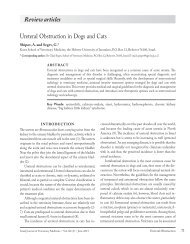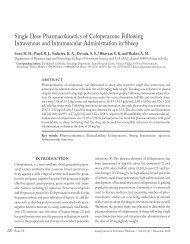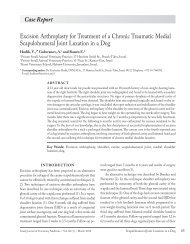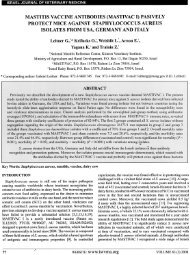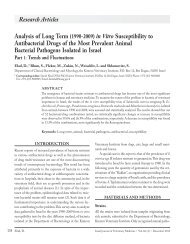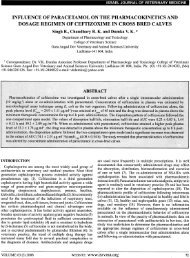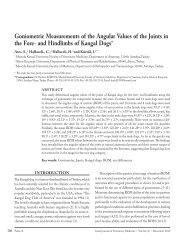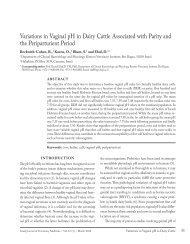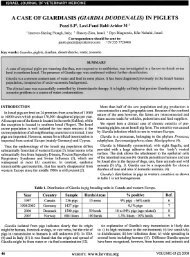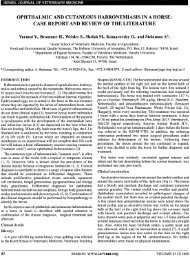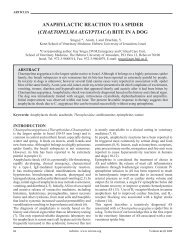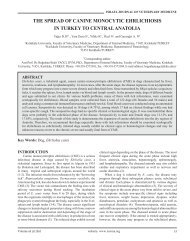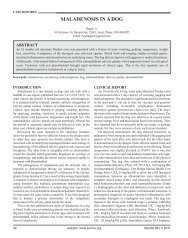A Novel Modified Semi-direct Method for Total Leukocyte Count in ...
A Novel Modified Semi-direct Method for Total Leukocyte Count in ...
A Novel Modified Semi-direct Method for Total Leukocyte Count in ...
Create successful ePaper yourself
Turn your PDF publications into a flip-book with our unique Google optimized e-Paper software.
Research Articles<br />
the TLC was also determ<strong>in</strong>ed based on the number of heterophils<br />
and eos<strong>in</strong>ophils counted <strong>in</strong> five squares <strong>in</strong> one chamber<br />
of the ruled area of the hemocytometer, as well as based<br />
on the number of these cells <strong>in</strong> the correspond<strong>in</strong>g five squares<br />
<strong>in</strong> its other chamber. This procedure was repeated 15 times<br />
<strong>for</strong> one of the samples, and two to three times <strong>for</strong> the other<br />
12 samples (a total of 45counts). The follow<strong>in</strong>g <strong>for</strong>mula was<br />
used to calculate the TLC: TLC [cells/µL] = (heterophils +<br />
eos<strong>in</strong>ophils counted <strong>in</strong> five hemocytometer squares) X100<br />
[i.e., dilution factor]) X 2 X 100 / (% heterophils + % eos<strong>in</strong>ophils<br />
obta<strong>in</strong>ed by DLC <strong>in</strong> Romanowsky-sta<strong>in</strong>ed blood<br />
smears of the bird). The correlation and agreement between<br />
the TLC’s calculated, based on each chamber of the hemocytometer<br />
were determ<strong>in</strong>ed. F<strong>in</strong>ally, a s<strong>in</strong>gle sample of avian<br />
blood was counted 15 times by a s<strong>in</strong>gle person (NT) us<strong>in</strong>g<br />
the MSDTLC and the agreement between counts was<br />
determ<strong>in</strong>ed.<br />
Statistical methods<br />
Descriptive statistics <strong>for</strong> each cont<strong>in</strong>uous variable were per<strong>for</strong>med.<br />
The distribution of data (normal vs. non-normal)<br />
was assessed us<strong>in</strong>g Kolmogorov-Smirnov test. Student's<br />
t- and Wilcoxon-rank-sum tests were used to determ<strong>in</strong>e<br />
whether the mean difference of two test results was different<br />
from zero. The one-sample Student's t-test was used to<br />
determ<strong>in</strong>e if the absolute difference between the mean of<br />
two repeated counts was different from zero. Pearson’s correlations<br />
were calculated between pairs of the test results.<br />
An <strong>in</strong>terclass absolute agreement correlation (ICC) between<br />
tests was also calculated. An ICC of 0.7 was considered as<br />
good agreement, while higher values were considered as very<br />
good. All tests were two-tailed, and a P ≤0.05 was considered<br />
significant. Statistical analyses were per<strong>for</strong>med us<strong>in</strong>g a<br />
statistical software package (SPSS 15.0 <strong>for</strong> W<strong>in</strong>dows, SPSS<br />
Inc. Chicago, IL).<br />
Assessment of the ideal sta<strong>in</strong><strong>in</strong>g solution dilution and<br />
blood cell sta<strong>in</strong><strong>in</strong>g<br />
Dilution of the sta<strong>in</strong> solution with sal<strong>in</strong>e led to <strong>in</strong>tense erythrocyte<br />
sta<strong>in</strong><strong>in</strong>g compared to the granulocytes, mak<strong>in</strong>g differentiation<br />
between them difficult us<strong>in</strong>g X200 magnification,<br />
and there<strong>for</strong>e necessitat<strong>in</strong>g the use of higher magnifications,<br />
and thereby protract<strong>in</strong>g the count. Based on the criteria mentioned<br />
above, the optimal sta<strong>in</strong> dilution was 1:10. This diluted<br />
sta<strong>in</strong> solution was mixed with the birds' blood sample (990<br />
and 10 µL, respectively, thus yield<strong>in</strong>g a f<strong>in</strong>al blood dilution of<br />
1:100). At that dilution, the heterophils and eos<strong>in</strong>ophils were<br />
readily recognizable, with good contrast and background,<br />
while sta<strong>in</strong><strong>in</strong>g of the erythrocytes was weak, allow<strong>in</strong>g easy<br />
differentiation of the granulocytes from erythrocytes (Figure<br />
1). A good quality granulocyte sta<strong>in</strong><strong>in</strong>g was also observed<br />
us<strong>in</strong>g a 1:5 dilution, however, erythrocytes sta<strong>in</strong>ed more <strong>in</strong>tensely,<br />
and this slowed the granulocyte count. Dilutions of<br />
1:25 and 1:50 were judged to provide poor, unacceptable results,<br />
due to low contrast and difficulty to accurately identify<br />
the granulocytes.<br />
Us<strong>in</strong>g the 1:10 dilution, the cytoplasm of erythrocytes,<br />
heterophils and eos<strong>in</strong>ophils sta<strong>in</strong>ed clearly, allow<strong>in</strong>g their<br />
identification (Figure 2-A2; Figure 3-A1, A2). Lymphocytes,<br />
monocytes and thrombocytes did not sta<strong>in</strong>, and only their<br />
shadows were apparent, not allow<strong>in</strong>g clear def<strong>in</strong>ite identification<br />
of the cell type (Figure 2-A1, Figure 3-A3; Figure<br />
4-A1, A2). Several selected microscopic fields were marked<br />
us<strong>in</strong>g the coord<strong>in</strong>ates of the microscope tray and photographed<br />
at different magnifications. The identity of the gran-<br />
RESULTS<br />
Figure 1: Photograph of the hemocytometer field at X200<br />
magnification with a blood sample from bird, diluted with the<br />
sta<strong>in</strong><strong>in</strong>g solution at the chosen, best dilution (1:10). The arrows po<strong>in</strong>t<br />
to heterophils or eos<strong>in</strong>ophils, which are easily recognizable, because<br />
their granules absorb the eos<strong>in</strong>-based dye. The black circles mark area<br />
<strong>in</strong> which erythrocytes can be seen.<br />
114<br />
Aroch, I.<br />
Israel Journal of Veter<strong>in</strong>ary Medic<strong>in</strong>e • Vol. 68 (2) • June 2013



